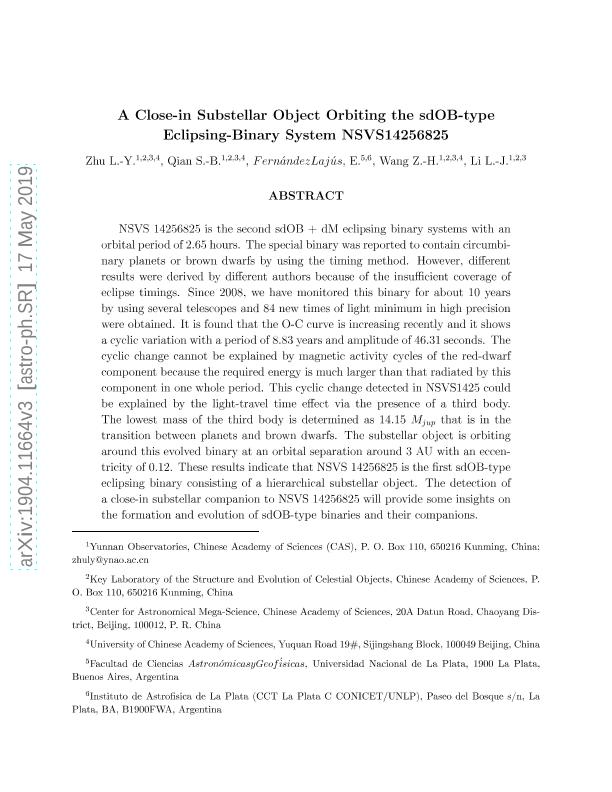Mostrar el registro sencillo del ítem
dc.contributor.author
Zhu, Li-Ying
dc.contributor.author
Qian, Sheng Bang
dc.contributor.author
Fernandez Lajus, Eduardo Eusebio

dc.contributor.author
Wang, Zhi Hua
dc.contributor.author
Li, Lin Jia
dc.date.available
2021-08-23T14:58:43Z
dc.date.issued
2019-09
dc.identifier.citation
Zhu, Li-Ying; Qian, Sheng Bang; Fernandez Lajus, Eduardo Eusebio; Wang, Zhi Hua; Li, Lin Jia; A Close-in Substellar Object Orbiting the sdOB-type Eclipsing-Binary System NSVS14256825; National Astronomical Observatories; Research In Astronomy And Astrophysics; 19; 9; 9-2019; 1-8
dc.identifier.issn
1674-4527
dc.identifier.uri
http://hdl.handle.net/11336/138697
dc.description.abstract
NSVS 14256825 is the second sdOB + dM eclipsing binary systems with anorbital period of 2.65 hours. The special binary was reported to contain circumbinary planets or brown dwarfs by using the timing method. However, different results were derived by different authors because of the insufficient coverage of eclipse timings. Since 2008, we have monitored this binary for about 10 years by using several telescopes and 84 new times of light minimum in high precision were obtained. It is found that the O-C curve is increasing recently and it shows a cyclic variation with a period of 8.83 years and amplitude of 46.31 seconds. The cyclic change cannot be explained by magnetic activity cycles of the red-dwarf component because the required energy is much larger than that radiated by this component in one whole period. This cyclic change detected in NSVS1425 could be explained by the light-travel time effect via the presence of a third body. The lowest mass of the third body is determined as 14.15 Mjup that is in the transition between planets and brown dwarfs. The substellar object is orbiting around this evolved binary at an orbital separation around 3 AU with an eccentricity of 0.12. These results indicate that NSVS 14256825 is the first sdOB-type eclipsing binary consisting of a hierarchical substellar object. The detection of a close-in substellar companion to NSVS 14256825 will provide some insights on the formation and evolution of sdOB-type binaries and their companions.
dc.format
application/pdf
dc.language.iso
eng
dc.publisher
National Astronomical Observatories

dc.rights
info:eu-repo/semantics/openAccess
dc.rights.uri
https://creativecommons.org/licenses/by-nc-sa/2.5/ar/
dc.subject
binaries : close
dc.subject
binaries : eclipsing
dc.subject
stars : evolution
dc.subject
stars: individual (NSVS14256825)
dc.subject.classification
Astronomía

dc.subject.classification
Ciencias Físicas

dc.subject.classification
CIENCIAS NATURALES Y EXACTAS

dc.title
A Close-in Substellar Object Orbiting the sdOB-type Eclipsing-Binary System NSVS14256825
dc.type
info:eu-repo/semantics/article
dc.type
info:ar-repo/semantics/artículo
dc.type
info:eu-repo/semantics/publishedVersion
dc.date.updated
2020-11-19T21:58:59Z
dc.journal.volume
19
dc.journal.number
9
dc.journal.pagination
1-8
dc.journal.pais
China

dc.journal.ciudad
Beijing
dc.description.fil
Fil: Zhu, Li-Ying. Yunnan Observatories, Chinese Academy Of Sciences; China
dc.description.fil
Fil: Qian, Sheng Bang. Yunnan Observatories, Chinese Academy Of Sciences; China
dc.description.fil
Fil: Fernandez Lajus, Eduardo Eusebio. Consejo Nacional de Investigaciones Científicas y Técnicas. Centro Científico Tecnológico Conicet - La Plata. Instituto de Astrofísica La Plata. Universidad Nacional de La Plata. Facultad de Ciencias Astronómicas y Geofísicas. Instituto de Astrofísica La Plata; Argentina
dc.description.fil
Fil: Wang, Zhi Hua. Yunnan Observatories, Chinese Academy Of Sciences; China
dc.description.fil
Fil: Li, Lin Jia. Yunnan Observatories, Chinese Academy Of Sciences; China
dc.journal.title
Research In Astronomy And Astrophysics

dc.relation.alternativeid
info:eu-repo/semantics/altIdentifier/doi/http://dx.doi.org/10.1088/1674-4527/19/9/134
dc.relation.alternativeid
info:eu-repo/semantics/altIdentifier/url/https://iopscience.iop.org/article/10.1088/1674-4527/19/9/134
Archivos asociados
